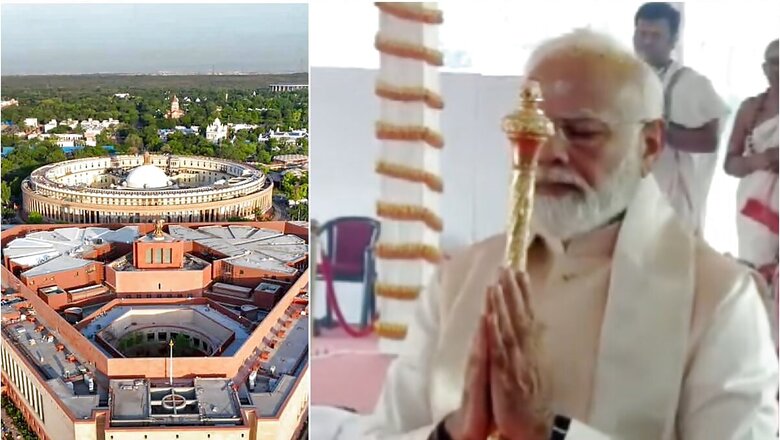
views
Much as they would like to obfuscate and subvert history, the Nehru-Gandhi Congress and their political extension — the Indian communist parties — have been stung by the revelation of the Sengol ceremony and of Jawaharlal Nehru’s participation in it. Evidence of various kinds exists to prove that the Sengol ceremony had indeed taken place and that their intellectual and secularist idol, Nehru, had acceded and had actively participated in the ceremony before delivering his midnight speech and hoisting the tricolour of free India.
The Congress party’s in-house historians and communist-leaning editors of some of India’s well-known English dailies may argue against such an occurrence, but their arguments and facts pale before the evidence that prove that the ceremony did take place. The Congress terming the episode as “bogus’, smacks of a pretended intellectual superiority and contempt for Indian traditions, which Nehru displayed intermittently and which his heirs, especially his great-grandchildren, have displayed consistently.
It is this pseudo-pride which has prevented them from appreciating or even from visiting the Pradhan Mantri Sangrahalay in Delhi, the first of its kind museum dedicated to all the Prime Ministers of India and not to one or two. While people from across the country flock to it in ever increasing numbers, the Congress first family has chosen to heap scorn on it and to ignore its essence and significance. Had the museum only depicted “Nehru”, “Indira” and “Rajiv” and had in flourish recounted their “sacrifices” for the people of India, it would have received their condescending approbation.
The Nehru-Gandhi Congress has always displayed a calculated ambivalence and disdain for Indian traditions and therefore the Sengol presented to Nehru, instead of finding a place of pride in the precinct of free India’s Parliament, found its way to the Anand Bhavan Museum where it was stored, relegated to a showcase, having been labelled as a “walking stick” gifted to Nehru.
It was a sense of “shame” and an overweening desire to disassociate themselves from India’s traditions that must have driven them to pack the Sengol off to Anand Bhavan as a walking stick, trying to paper over its sacredness, symbolism and dharmic and civilisational significance. The decimation of the Congress’ conservatives, post-Sardar Patel’s demise in December 1950, had, in a sense, been the greatest bane of the Congress party. The increasing grip of the party by Nehru and his political and ideological drum-beaters, led to the sidelining and to the eventual political decimation of the Congress conservatives. This unhinged the Congress from whatever little was left of its connection with India’s traditions and her civilisational ethos. Essentially foreign in thought, articulation and aspirations, the present Congress has increasingly steered away from the fundamental cultural and spiritual ethos of civilisational India.
Those parties who have refused to participate in the inauguration of the new Parliament building because the President of India has not been asked to inaugurate it and see in it an affront to the tribal community, were those very parties which had vehemently opposed her candidature and had supported the candidature of a tired, out of work politician from the general category. Their opposition on this count thus has no credence and lacks sincerity. They oppose the inauguration of the new Parliament because Narendra Modi sanctioned it and saw through its completion. They oppose it because he, and not them, displayed the political will, democratic conviction and sagacity to foresee its necessity in purely utilitarian terms and its deeper symbolism in terms of it signifying an India unshackled and leaping ahead on the seventy fifth year of her independence.
Displaying their customary illiteracy of India’s tradition, communists speak of the Sengol as re-establishing royal rule! They are ignorant of Chola traditions and the philosophy of a dharma-driven rule which is based on a sense of duty, equity, justice and compassion. Wouldn’t the communists from southern India know, for instance, of the existence of the Uttaramerur inscriptions, which speak of the duties of the elected and the rights of the electors?
As the late historian, R Nagaswamy, pointed out the unique democratic texture of the Uttaramerur inscriptions, “The village assembly of Uttaramerur drafted the constitution for the elections. The salient features were as follows: the village was divided into 30 wards, one representative elected for each. Specific qualifications were prescribed for those who wanted to contest. The essential criteria were age limit, possession of immovable property, and minimum educational qualification. Those who wanted to be elected should be above 35 years of age and below 70. A person serving in any of the committees could not contest again for the next three terms, each term lasting a year. Elected members who accepted bribes, misappropriated others’ property… or acted against the public interest suffered disqualification.”
It was a framework, a Constitution that was democratic in essence, in approach and in its working out, which the conflict-driven communist mindset can scarcely appreciate or evaluate. Essentially an autocratic outfit, inspired by injunctions of dictators who have experimented with mass extermination models, Indian communist parties can never really comprehend the Chola traditions, the contours of dharmic rule and its sanctity and duties. The laziest and the most sinister approach thus is to equate the return of the Sengol to a return to monarchy!
Never known to have supported or to have worked for India’s freedom struggle and of having supported its ideals, always known to have been a reluctant and opportunistic participant in India’s democratic march and her parliamentary system, known to have equated Parliament with a “Pigsty”, the communists’ sudden concern with constitutional propriety thus smacks of dishonesty!
In the 1930s and ’40s, these communists opposed India’s struggle for freedom, and immediately after Independence they announced an insurrection against free India. Free India’s first government spoke of how, the Communist Party of India, “which never tires of criticising the government for alleged suppression of democratic rights and liberties, have made it abundantly clear through oral and written propaganda as well as by their open activities that in their view such rights and liberties not only include the freedom to murder, maim, pillage and sabotage but also exclude the right of the State and the public to prevent and oppose such activities”. Now they oppose the symbols of India’s rise and her emergence as a prominent civilisational power.
The forces and elements which oppose the new Parliament building, who mock the Sengol, the Adheenams and their significance of connecting the best in our past with the best aspirations that we nurture, as a nation and civilisation, for our future, are those very forces which have been trying to retard our cultural self-articulation and self-possession. India’s rise is disconcerting for them; they seek to inflict conflict and strife, division and conflagration. In a new Parliament with the Sengol housed in it, they see a negation of their subversive agenda and roadmap.
The writer is Director Dr Syama Prasad Mookerjee Research Foundation, Member, BJP, National Executive Committee, Member of the National Committee for Netaji’s 125th Birth Anniversary. Views expressed are personal.




















Comments
0 comment